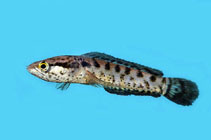| Family: |
Channidae (Snakeheads) |
| Max. size: |
53 cm TL (male/unsexed) |
| Environment: |
benthopelagic; freshwater, potamodromous |
| Distribution: |
Asia: Thailand to Indonesia. |
| Diagnosis: |
Dorsal soft rays (total): 37-41; Anal soft rays: 25-30; Vertebrae: 43-48. Patch of scales present on gular portion. Head and body with 2 bold stripes running from the tip of the snout to the middle of the caudal fin, one on the upper and the other on the lower part of the body; with growth the bands gradually break up into several (5-9) black blotches in adults (Ref. 41526). Belly with oblique bars; 5 scale rows between lateral line and base of anterior dorsal rays (Ref. 43281). |
| Biology: |
Inhabits slow moving streams and rivers, as well as lakes, ponds (Ref. 12693) and swamps (Ref. 57235). A common species in forest streams (Ref. 56749). Often found in areas with plenty of aquatic vegetation, as well as submerged woody plants. Feeds on fishes, prawns, and crabs and slightly less on shrimps. Marketed fresh and often alive (Ref. 12693). |
| IUCN Red List Status: |
Least Concern (LC); Date assessed: 26 November 2019 Ref. (130435)
|
| Threat to humans: |
harmless |
Source and more info: www.fishbase.org. For personal, classroom, and other internal use only. Not for publication.

